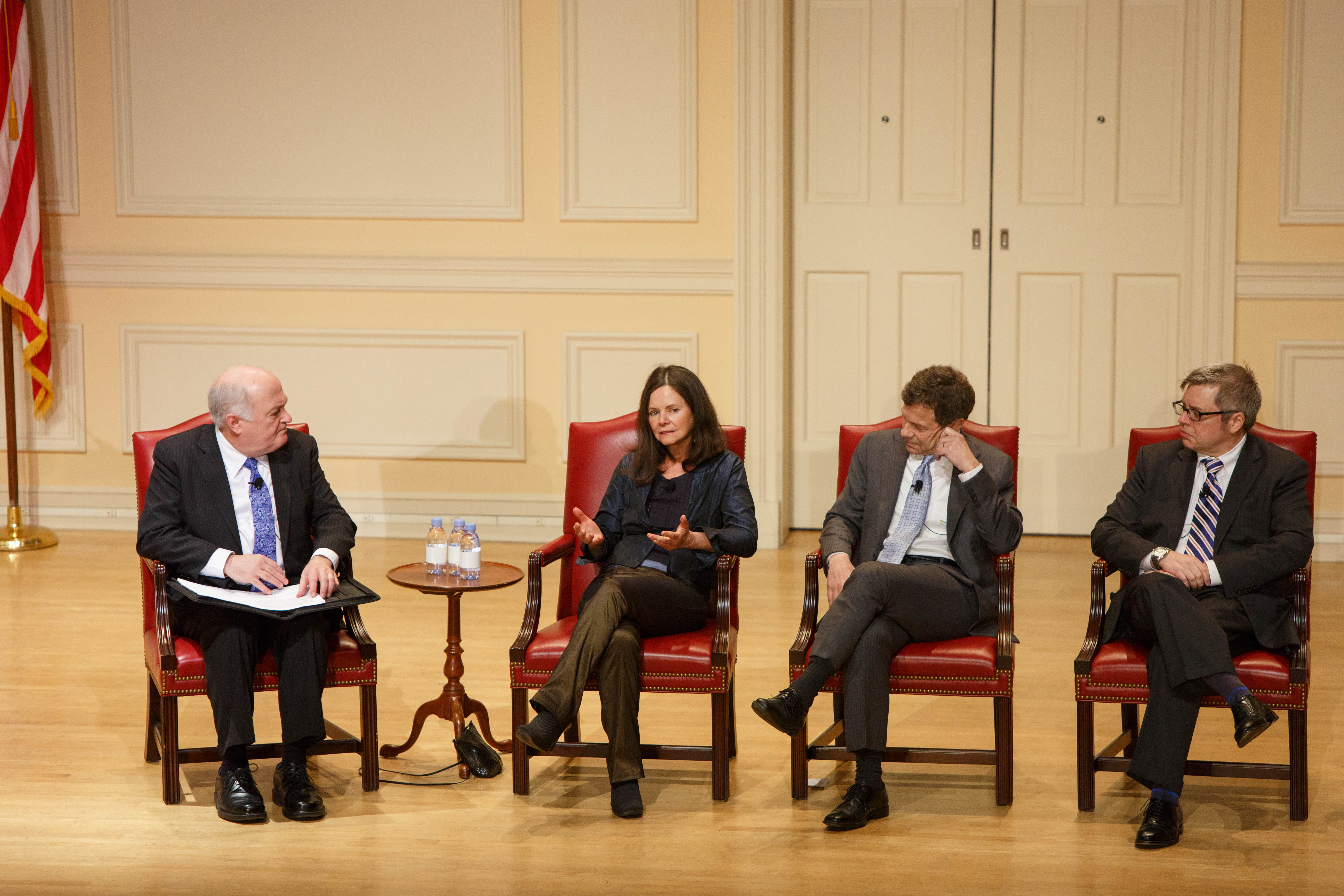By Ruth Steinhardt
It is rare to participate in a high-level literature seminar that includes three Pulitzer Prize winners, a National Book Award finalist and a university president—rarer still for such a class to meet at the Library of Congress’s approximately 400-seat Coolidge Auditorium.
But such was the atmosphere when George Washington President Steven Knapp moderated a discussion on how religious faith informs the work of novelist Marilynne Robinson, winner of the Library of Congress 2016 Prize for American Fiction.
Called “Fiction, Faith and the Imagination,” the panel comprised novelists Geraldine Brooks and Paul Harding—both, like Ms. Robinson, Pulitzer Prize winners—as well as writer and physicist Alan Lightman, whose novel “The Diagnosis” was a finalist for the 2000 National Book Award in fiction. Ms. Robinson joined the discussion for its final segment.
“Our topic is the relationship between faith and the imagination, and I’m not aware of more compelling instance of that relation in modern literature than the way Marilynne Robinson reimagines the Christian—and more specifically the Calvinist—conception of divine grace,” Dr. Knapp said.
A surprise message read by Jane McCauliffe, director of national and international outreach at the Library of Congress, and written by former President Barack Obama, a friend and admirer of Ms. Robinson, opened the program.
“She not only draws us into the texture of the people and the communities she creates, but wraps us all together into something larger: a patchwork of characters and readers and author, of our struggles and our delights, of our faith, our doubts, our redemption, and in so doing she elevates our understanding of what it means to be fully human,” Mr. Obama wrote. “That’s what the highest of art can achieve, it’s what the greatest library in the world should celebrate, and it is what Marilynne Robinson seems to radiate every time she sits down to write.”
Ms. Robinson’s best-known trilogy, which includes the novels “Gilead,” “Home” and “Lila,” centers on the lives and families of two Midwestern ministers. Characters struggle explicitly with the demands of faith, with its effects on personal relationships and—conversely—the incursions of worldly concerns on spiritual life.
Ms. Robinson’s work is uniquely positioned to address that conflict, Ms. Brooks said, “because she sees the mystical and the religious in the ordinary. It doesn’t have to be a virgin birth to be wonderful, because any birth is a miracle. Once you have that thought, who needs to argue whether the world was created in six days? It becomes a magnificent irrelevancy. You can have the faith without that.”
Mr. Harding, a former student of Ms. Robinson, linked the very act of writing—of creative work more generally—to a kind of faith-based action.
“The act of creating art is a discipline of observation,” he said, which is also “an act of devotion, an act of obedience, an act of prayer.”
Dr. Knapp, a professor of English, has himself written on the conflicts and confluences between faith and the worldly in “The Predicament of Belief: Science, Philosophy, Faith,” co-authored with Philip Clayton, a professor of religion at Claremont University. He pressed Dr. Lightman on the point: can faith be compatible with empirical science?
Dr. Lightman said faith is not merely compatible with science: it is part of the most fundamental scientific dogma.
“For me, faith is a belief in something you can’t prove,” he said. “The kind of faith that scientists have is something very, very fundamental—one might call [it] the central doctrine of science—[which] is that the universe is lawful and logical. That’s a doctrine we scientists learn as graduate students, maybe not consciously, but it’s a belief that we absorb almost by osmosis into the skin.
“But it’s a belief that can’t be proved. There are things scientists don’t know, and we can’t be certain that all parts of the universe are lawful and logical. We don’t know for sure whether some new phenomena, discovered tomorrow, will be lawful and logical. That has to be taken on faith.”
Ms. Robinson joined the panel for its last half hour and audience questions, laughingly characterizing the preceding discussion of themes and recurrences in her work as “like the most self-indulgent fantasy I’ve ever had.”
“I have become deeply immersed in a theology that I basically inherited,” said Ms. Robinson, who was born and raised Presbyterian and has since become Congregationalist. “I felt as if, if you granted the terms of that theology, it would tell you certain kinds of things.”
One of the things her immersion faith taught her, she said, is that “the beautiful is a signature of God.”
“It’s almost a question of individual consciousness whether or not you perceive the beautiful, but the assumption is that it’s always there, one way or another, to be perceived,” she said.
When an audience member asked whether being in the presence of beauty could “make us better people,” Ms. Robinson hesitated.
“I think that we are made better people by being attentive to beauty perhaps in forms that have not yet been perceived as beautiful,” she said. “I think it’s much more a habit of mind that is called for, rather than disciplining one’s attention to what has already, by consensus, been called beautiful.”


